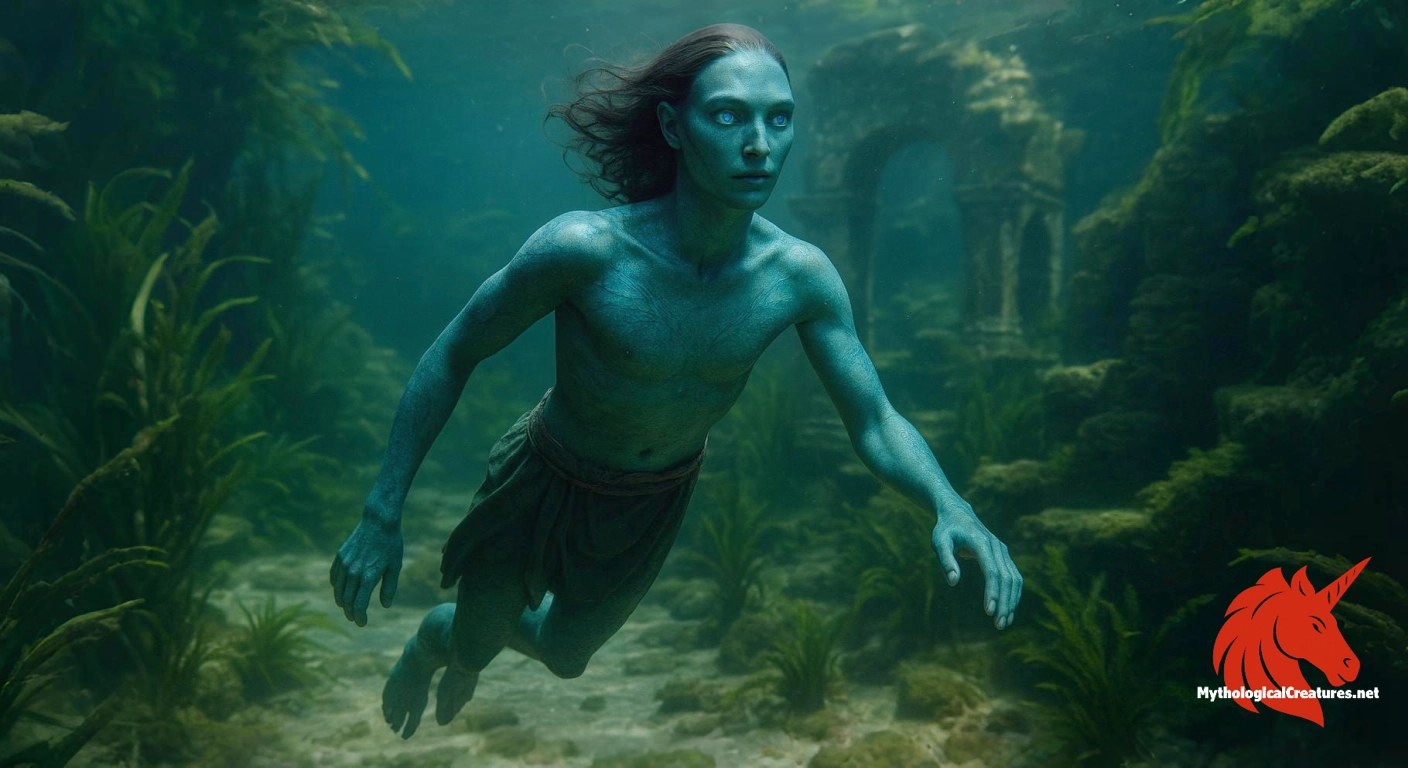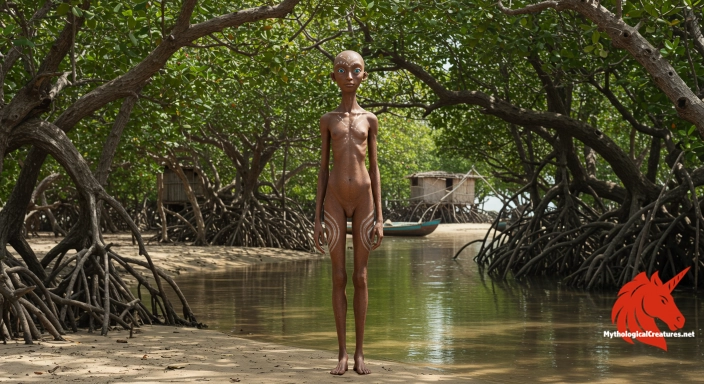Yacuruna: The Yacuruna are mythical water people from the Amazon basin, famed for their beautiful underwater cities near river mouths.

Yacuruna
Yacuruna - They embody the mysterious and transformative qualities of water within the cultural landscape of the Amazon.
Origins & First Encounters
The legends of the Yacuruna are rich and enigmatic, embodying the mystique of the Amazon basin’s watery domains. Their origins are steeped in the traditions of indigenous peoples, told in a tapestry of oral narratives that span centuries. The name itself, derived from the Quechua words for water (yaku) and man (runa), hints at their dual nature as both human-like and otherworldly entities. These beings are said to dwell in exquisite underwater cities, often situated at the mouths of great rivers where the flow of water and life converges. Early attestations of their lore are entwined with the cultural identities of riverine communities who revered and feared the unpredictable forces of nature. The Yacuruna are depicted neither as entirely benevolent guardians nor as solely malevolent tricksters, but rather as complex figures integral to the cycle of life and water. Their myth served to illuminate the spiritual and environmental forces at work in the dense Amazonian wilderness. The enduring presence of these tales reflects the deep interconnection between the people and the powerful aquatic landscapes they inhabit. As living embodiments of water’s mysticism, the Yacuruna persist as symbols of nature’s beauty, mystery, and ever-changing character.
Source Texts & Tale Variants
The narrative of the Yacuruna is primarily preserved through a wealth of oral traditions, passed down by indigenous shamans and elders in the Amazon. These stories have been recounted over generations, with each iteration echoing the region’s intimate relationship with the natural world. Early explorers and colonial chroniclers occasionally mentioned mysterious water people whom they encountered in their tales, although these accounts were often fragmented and coloured by external interpretations. Ethnographic records later aimed to capture these elusive myths, thus preserving a variety of versions that have evolved over time. Folklorists and cultural historians have documented distinct motifs within the Yacuruna lore, highlighting variations that emphasise both the benevolent and the perilous aspects of these beings. Some narratives depict the Yacuruna as mystical healers and custodians of secret wisdom, while others honour them as capricious entities who enforce natural order. The multiplicity of these sources underlines the fact that the myth has adapted to diverse regional and temporal contexts. The varied accounts collectively underscore the dynamic and adaptive nature of indigenous storytelling in the Amazon.
Form & Powers
Depictions of the Yacuruna often blend human elegance with aquatic surrealism, creating images that are both captivating and otherworldly. Their skin is frequently described as having a shimmering, iridescent quality, reminiscent of the hues seen in a river under the bright light of day. Some traditions portray their hair as flowing and fluid, merging effortlessly with the surrounding water like strands of luminous algae. Eyes with an almost amphibious clarity are said to illuminate in the dark depths, capturing the reflective mystery of underwater realms. In many accounts, their limbs are depicted as gracefully adapted for swimming, complete with webbed digits that suggest an affinity for the aquatic environment. Their facial features, while strikingly human, are touched with a supernatural allure that sets them apart from ordinary mortals. Varying regional descriptions note differences in stature, with some traditions painting them as tall and imposing, whereas others hint at a smaller, sprite-like presence. Adornments crafted from river resources, such as shells and polished stones, are often seen as emblematic of their deep connection to water. This intricate amalgamation of human and aquatic elements lends the Yacuruna an air of timeless magic and mystery.
Regional Faces
Regional interpretations of the Yacuruna vary widely across the vast expanse of the Amazon basin, reflecting local environmental and cultural influences. In some indigenous communities located near winding waterways, these water people are celebrated as benevolent custodians who safeguard the health and vitality of surrounding ecosystems. In contrast, other regions portray them as cautionary figures whose appearances forewarn of tumultuous natural events. Variants from the Peruvian Amazon, for instance, incorporate elements of enchanting music and hypnotic dances, suggesting that the Yacuruna communicate with the rhythms of the river. Brazilian adaptations of the myth sometimes merge the Yacuruna with local spirit traditions, infusing them with characteristics similar to those found in other water deities. In areas where Euro-American influences have intermingled with indigenous lore, the narratives have occasionally adopted elements reminiscent of European water sprites and mermaids. Despite their diverse portrayals, a common thread persists: the Yacuruna remain emblematic of the unpredictable forces of water. This regional diversity underscores the myth’s capacity to transform in response to the unique cultural practices and ecological realities of different localities.
Cultural Parallels
The Yacuruna share fascinating parallels with other mythological water spirits found across the globe, creating a bridge between disparate cultural traditions. Much like the mermaids and selkies of European folklore, these water beings exhibit a duality that melds enchanting beauty with an underlying potential for danger. Similar to the river gods and goddesses of various African and Asian cultures, the Yacuruna embody the delicate balance between creation and destruction inherent in natural waters. Their portrayal often mirrors themes seen in indigenous myths that celebrate transformation through nature, highlighting the universal human experience of reverence and caution towards water. Comparative analysis reveals that many cultures adapt similar archetypes—hybrid creatures who defy conventional understanding of form—to personify the unpredictable character of aquatic environments. The interplay between human-like features and aquatic adaptations is a recurring motif that symbolises life’s fluidity and constant change. Despite the local particularities in each narrative, the Yacuruna and their global counterparts all serve as potent metaphors for nature’s abundance and its inherent perils. Their cross-cultural resonance emphasises a shared recognition of water as both a life-sustaining force and an enigmatic wilderness.
Legacy & Modern Evolution
The myth of the Yacuruna has undergone a remarkable evolution from its ancient, orally transmitted origins to its role in modern cultural expressions. Early legends served not only as explanations of the natural world but also as repositories of environmental wisdom and spiritual connectivity for indigenous communities. As these communities faced increasing contact with external influences and modernisation, the Yacuruna myth adapted, absorbing new symbolic layers reflective of contemporary concerns. Modern reinterpretations have cast these water people as allegories for the delicate balance between human civilisation and the natural environment, especially in an era marked by ecological uncertainty. Contemporary literature, visual arts, and even cinema have embraced the allure of the Yacuruna, turning them into emblems of both environmental mysticism and cultural heritage. Indigenous voices continue to revitalise these narratives, ensuring that the ancient myth serves as a continual reminder of a profound connection to the waterways that sustain life. The Yacuruna now stand as symbols of resistance against environmental degradation, embodying a timeless dialogue between tradition and modernity. Their enduring legacy testifies to the power of myth in shaping cultural identity and preserving the sacred relationship between people and nature.
Interesting Fact
An intriguing aspect of Yacuruna lore is their reputed ability to traverse between human and aquatic forms, symbolising the fluid boundary between land and water.
Quick Creature Info
Origin:
Features:
Associations:
Our Mythic Legendary Rating:

Habitat:
Supernatural Powers:
Physical Attributes:
Abilities:
Behavior:
Weaknesses:
Lore:
References
Discover Another Mythical Legend You May Not Have Heard Of?
Uncover the mysteries of ancient folklore and expand your knowledge of legendary beings from cultures around the world.
Dare to Meet the Yumboes....
Mythical Disclaimer: The images and data on this site are derived from various historical and literary sources, but we have found that many myths often have multiple versions and interpretations across references, sometimes contradictory. As a result, these creature depictions are artistic interpretations—imaginative blends of folklore, legend, and a dash of AI guesswork. Because creature descriptions vary widely, our illustrations and accompanying information represent our best effort to honor mythology while bridging creative gaps. Enjoy these interpretations—just remember, we've done our best to respect the stories and validate available data, but in the realm of mythology, details often shift, imagination leads the way, and nothing is ever set in stone!
Curated by the Mythological Creatures Team (rev. May 2025)
